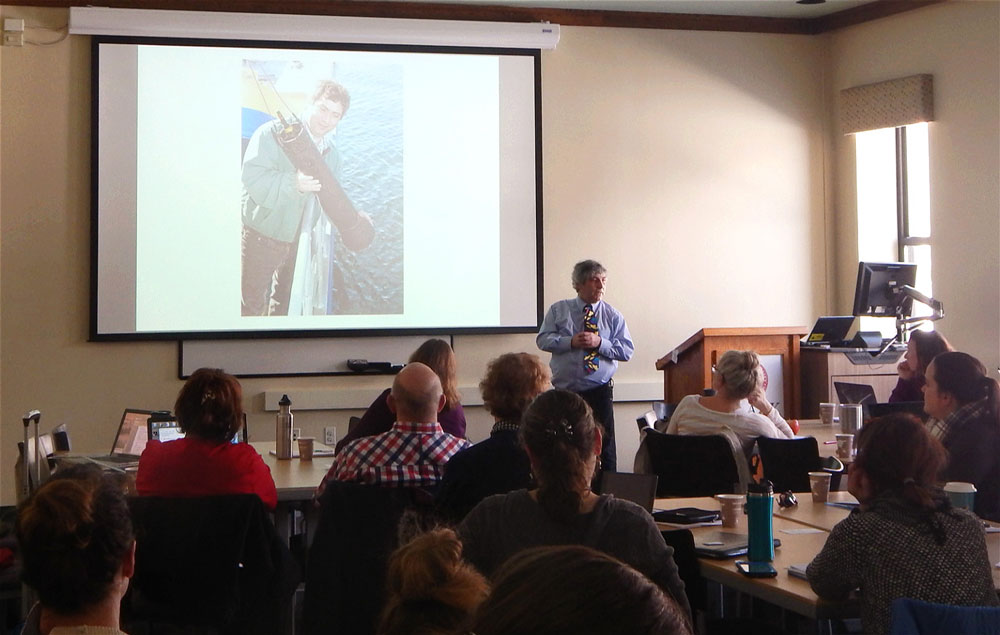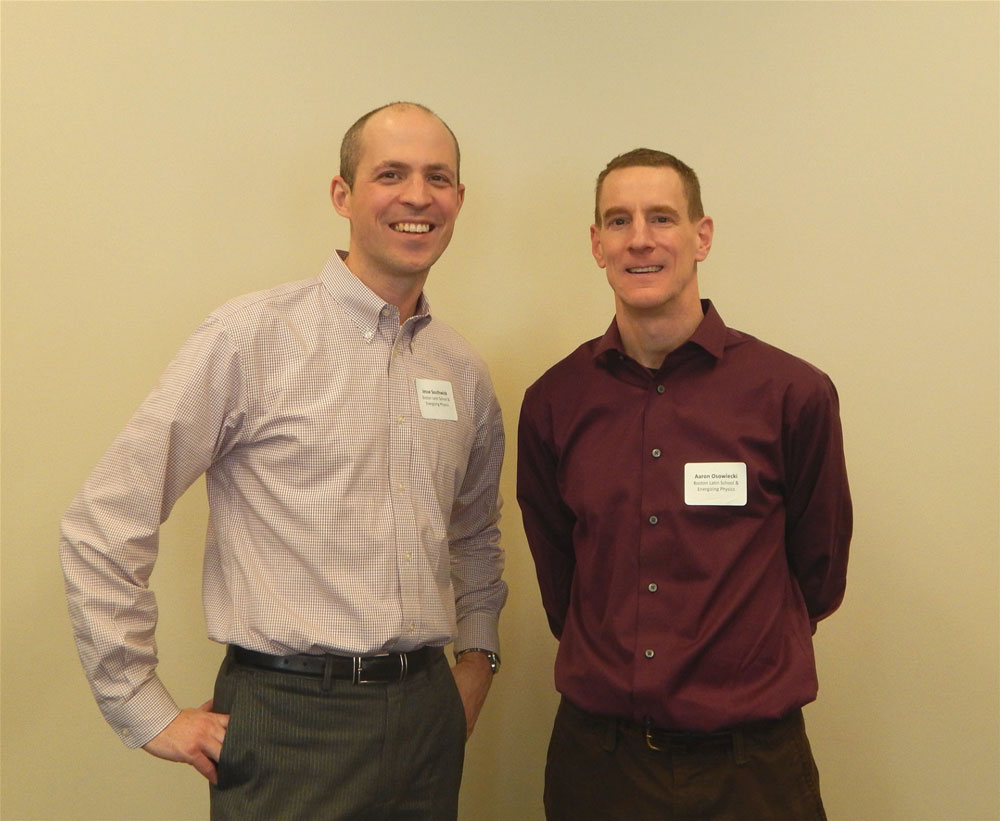Tuesday, February 14, 2017
For Immediate Release
MITS Professional Development Seminar Puts a Spotlight on Engineering and Math
Wednesday, January 25th was the first of four monthly sessions in the Museum Institute for Teaching Science (MITS) 2017 Professional Development Seminar series. Educators participating in the seminar examined applications of the Science and Engineering Practices: Constructing Explanations and Designing Solutions, and Using Mathematics and Computational Thinking. In the morning, participants dove into ocean engineering, and in the afternoon they designed their own system for measuring speed.
Engineering Goes Underwater
During a presentation by Paul Fucile, Senior Engineer at Woods Hole Oceanographic Institution (WHOI),  educators learned more about the world of engineering for ocean science research. Paul set the stage by telling a childhood story of witnessing a rocket losing its engine, an event that intrigued him and fueled his fascination for science, technology, engineering and math (now termed “STEM”).
educators learned more about the world of engineering for ocean science research. Paul set the stage by telling a childhood story of witnessing a rocket losing its engine, an event that intrigued him and fueled his fascination for science, technology, engineering and math (now termed “STEM”).
The presentation offered unique insight into the role of an engineer in a research institution. Explaining that his goal to work at NASA was altered by a summer opportunity at WHOI, Paul said his first job there gave him practical, hands-on experience building robotic boats and coding for shark research. He described how asking the right questions led to his multiple U.S. patents, including one for a “low-cost, compact bathyphotometer”, which he designed (in 8 weeks) for the U.S. Navy to detect bioluminescence.
Paul engineers underwater instrumentation for scientific data collection and he talked about his extensive work on AVDs (Autonomous Vehicle Development) with a focus on gliders.
“We can’t talk to these [AVD’s] because they’re underwater. The only way is acoustically or sometimes optically” he said.
As their name implies, gliders have wings. They are relatively silent since they lack propellers, and their neutral buoyancy allows them to float just at the surface of the ocean. Gliders are power efficient and can be deployed for long-duration research (over one month), descending up to 300 meters. The “science payload” is encased in the center of the apparatus; this includes extremely accurate clocks and oceanic sensors (an acoustic monitoring system and a spectograph). WHOI’s glider was tested in the Gulf of Maine in 1995. Though unplanned, a nearby NOAA buoy transmitted comparable data that helped validate that the glider was working correctly.
them to float just at the surface of the ocean. Gliders are power efficient and can be deployed for long-duration research (over one month), descending up to 300 meters. The “science payload” is encased in the center of the apparatus; this includes extremely accurate clocks and oceanic sensors (an acoustic monitoring system and a spectograph). WHOI’s glider was tested in the Gulf of Maine in 1995. Though unplanned, a nearby NOAA buoy transmitted comparable data that helped validate that the glider was working correctly.
While engineers typically engage in defining problems and designing solutions, every now and again opportunities for exploration pop up. Paul revealed that one of his career highlights was being asked to join a dive in the HOV Alvin. There is no heat in the submersible, so hot air is pumped into the cabin just before launch. The pilot, Paul and one other sat in the dark to conserve power during the two and a half-hour descent. Paul smiles as he remembers listening to a recording of Bob Marley and the Wailers on the cold journey down. When they reached the bottom, they turned on the lights and took in the wonders of the ocean during an hours-long deep dive.
Using Mathematics and Computational Thinking
How can speed be measured without the use of standard units like meters and seconds? Aaron Osowiecki and Jesse Southwick,  physics teachers at Boston Latin School and developers of Energizing Physics, challenged educators with this task during the afternoon session as an example of ways to involve student learners in the practice of Using Math and Computational Thinking. Participants quickly realized that this challenge would involve two parts – devising a way to measure distance and a way to measure time. Choosing from a variety of supplies (water bottles, string, salt, marbles, etc.), participants went to work to develop new units of measurement.
physics teachers at Boston Latin School and developers of Energizing Physics, challenged educators with this task during the afternoon session as an example of ways to involve student learners in the practice of Using Math and Computational Thinking. Participants quickly realized that this challenge would involve two parts – devising a way to measure distance and a way to measure time. Choosing from a variety of supplies (water bottles, string, salt, marbles, etc.), participants went to work to develop new units of measurement.
When the group came together to share their ideas, it was clear that participants took many different approaches. They had measured  distance by number of floor tiles, table lengths, and cardboard boxes. Time had been measured with a pendulum, heartbeats, and a homemade “hourglass”. The resulting list of speeds was a jumble of values, ranging from 0.2 to 127, and a variety of units.
distance by number of floor tiles, table lengths, and cardboard boxes. Time had been measured with a pendulum, heartbeats, and a homemade “hourglass”. The resulting list of speeds was a jumble of values, ranging from 0.2 to 127, and a variety of units.
Because the session focused on the Science and Engineering Practice of Using Math and Computational Thinking, it included some discussion defining the practice. Educators concluded that computational thinking is a universal sense of numbers and the concepts behind the numbers. In order to understand the “language of math”, as one educator termed it, we make use of standard units that help us compare and communicate our findings.
More about MITS 2017 Professional Development Seminar Series
Professional Development Seminars are designed for professionals from science, environmental, natural history, technology, history and other cultural institutions and centers in New England. Seminars are designed as professional development opportunities to provide content and teaching resources as well as networking opportunities for professionals in informal education settings. Each seminar is a full day session. The mornings are spent exploring STEM content areas with scientists, researchers and policy makers. Afternoon sessions are skill-based, focusing on turning real-life science into exciting, inquiry-based, minds-on, hands-on lessons and activities for K-12 students and teachers.
A list of upcoming seminars and registration information can be found at https://www.wadeinstitutema.org/2017-professional-development-seminar-series/.
###
The Museum Institute for Teaching Science specializes in providing hands-on, minds-on, inquiry-based STEM professional development for formal and informal educators. For more information, visit www.mits.org or call 617-328-1515.
